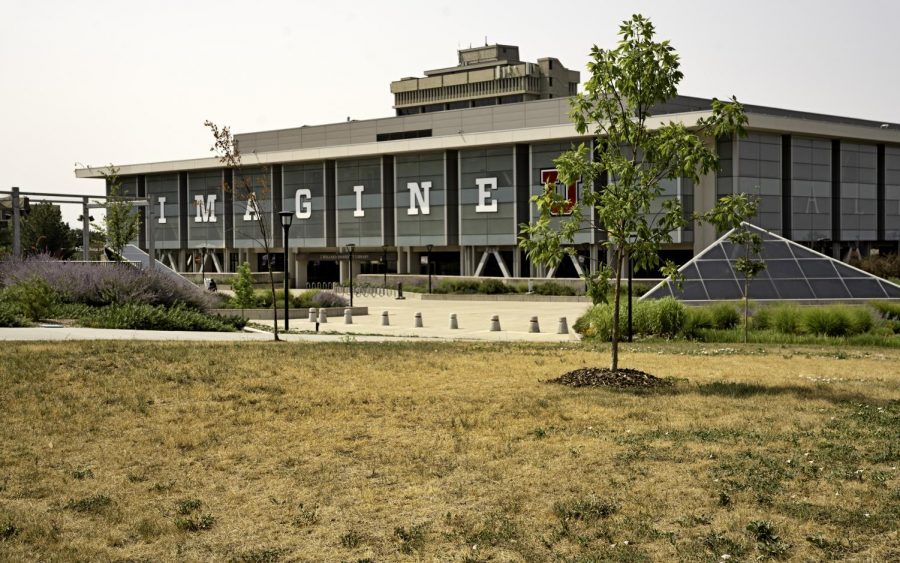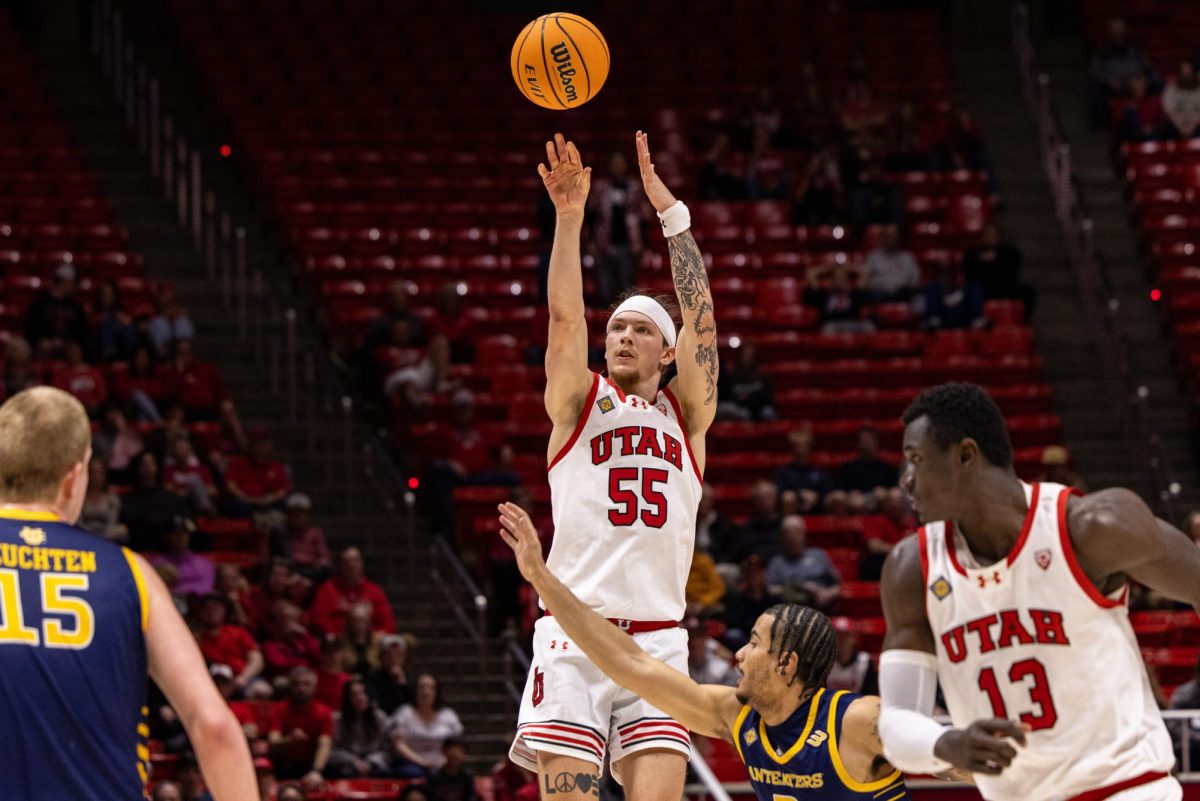Cushman: Utah Needs to Wage War on Grass in Public Spaces
The drought’s effect on campus with view towards the Marriott Library on July, 24 2021. (Photo by Kevin Cody | The Daily Utah Chronicle)
May 20, 2022
Recently, West Valley City replaced sections of grass at its city hall with artificial turf. After seeing it last well through winter, the municipality voted to officially legalize artificial turf. While it wasn’t prohibited before, the vote encourages more artificial turf around the city. Given Utah’s intense drought conditions, more of Utah’s public spaces need to follow West Valley’s example and utilize water-wise landscaping solutions.
According to the Utah Division of Water Resources, “99.45% of the state is in severe drought or worse, with 43.46% of Utah in extreme drought.” As a result, Utah’s reservoirs sit at 60% capacity, a marked 7% drop from last year’s levels. This year, we haven’t yet reached the high water use period of summer, but conditions have already forced Gov. Cox to enact an drought emergency order.
Drought conditions affect all of Utah’s wildlife. Less water means shrinking fish habitats, less vegetation to provide food for other wildlife and monumental changes to environments. Some of these changes affect where bears roam and birds fly during migration. Human interactions have caused the Great Salt Lake to drop 11 feet since the first pioneers traveled here. Drought speeds up that process, posing danger to our state’s beloved landmark. Utah is known and loved for its beautiful landscapes and wildlife. Drought threatens that reputation.
Beyond that, though, drought has hefty economic consequences. The Utah Division of Water Resources describes drought as “among the most financially burdensome of all weather-related disasters.” Between 1980 and 2020, 26 droughts cost the U.S. at least $249 billion. When water becomes scarce, farmers often lose water supply first, resulting in increasing food costs for consumers. Agriculture is a $1.8 billion industry in Utah. When food prices rise, our farmers (and GDP) face huge monetary losses.
Utah has endured drought for years now, and each year we have less water in reserve. Yet, action to resolve drought conditions remains slow and grass lawns continue to exacerbate the problem. Unlike other arid states like Nevada, many Utahns maintain grass lawns despite our climate not supporting it. Walking down any residential street in especially northern Utah, you’re bound to see most houses with grass lawns.
Nationwide, about half of outdoor water use is dedicated to lawns and gardens. According to Scott’s (a lawn care company), the average lawn requires 1-1.5 inches of water each week. In Utah, where we grow mostly thirsty bluegrass (that thrives in 60-75 degree temperatures), hot and arid summers demand even more than that for grass to survive. Additionally, about half of the water we use for outdoor irrigation gets wasted or evaporates.
Ultimately, Utah’s grass makes for nice lawns, but provides little to the land or people in our state. As water becomes increasingly scarce in our rivers, lakes and reservoirs, grass lawns only hurt us.
To combat this, our state and some municipalities have implemented water conservation strategies. During the 2022 legislative session, for instance, secondary water metering by 2030 became a requirement throughout the state. The general manager of the Weber Basin Water Conservancy District, Tage Flint, explained to the Salt Lake Tribune that this would ideally result in 20-30% water savings. Utah also became the first state to implement a statewide turf buyback program so homeowners can have the cost of grass removal partially covered by the state. People have pushed to stop municipalities and HOAs from prohibiting water-wise landscaping solutions.
These proposals do make water-wise landscaping easier for residents. But until grass alternatives become more regular, Utah lawns will continue to waste precious water while our wildlife and economy suffer. Other Western states are working to combat the waste of water on grass. Nevada will cut 10% of their Colorado River consumption by removing “ornamental” grass (grass in road median areas, park strips, some commercial areas, etc.). We should follow in similar footsteps.
Here in Salt Lake, all our parks have vast grass spaces, many sidewalks and medians have ornamental grass, etc. Our campus alone contains many grass spaces. Our government buildings have grass lawns. We need to wage war on grass in these spaces to encourage homeowners to make water wise changes and make important impacts on state water use. Our infrastructure should reflect the severity of our drought conditions.
West Valley replaced some grass at its city hall with artificial turf as an experiment, one that they saw worked well. Utah’s public spaces need to look to grass alternatives like artificial turf and xeriscaping so that homeowners might do the same.
So far, the fight against grass in Utah has been centered around making grass removal and water conservation easier for homeowners. These solutions are positive steps forward, but they don’t acknowledge the huge amounts of water wasted in unnecessary public grass-dominated spaces. Incremental progress will work until our water shortage destroys much of Utah’s natural beauty and hurts our economy. I want to see our state protect its wonders by removing grass in public spaces and fighting against drought.









Todd Krishan • Jan 13, 2023 at 11:06 am
This is about the worst environmental, health and lawncare advice anyone could apply, and West Valley should be ashamed for taking an easy way out that contributes to destroying their community. Synthetic turf is dangerous to health and environment. It’s like filling the earth with burning tires and the heat causes the materials its made of to give of carcinogenic and other dangerous gases that are harmful to to people and animals. Putting down artificial turf might be the one thing that’s more dangerous to the environment and human health than thirsty grass actually is.